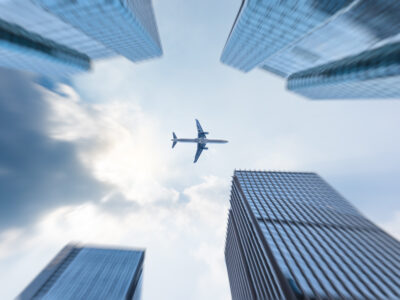
Airspace closure
One of the most important events of the last weeks for the entire aviation world was the closure of the EU airspace and several other countries to Russian aircrafts in response to military operations in Ukraine and symmetric, retaliatory closure of skies over Russia. What is the airspace closure from a legal point of view and what are the consequences?
Airspace under aviation law
When speaking in the context of the Ukrainian conflict about the airspace closure, whether over the EU or over Russia, we mean, of course, the national airspace defined as an airspace extending over the territory (land, inland maritime waters and territorial sea) of a specific state over which this state has sovereignty, or the right to decide about everything that happens within it.
In other words, the national airspace is an exclusive domain of the state over which it extends, and is under its authority, what results from Article 1 of the Chicago Convention. The air sovereignty of a state includes the following powers:
- prohibiting international flights within its territory,
- subjecting the operation of such flights to the regulations, conditions and restrictions determined by this state and controls of the relevant authorities,
- establishing and executing within its territory its own jurisdiction also with relation to foreign aircrafts and persons and goods onboard these aircrafts, as well as offenses and other acts committed onboard of these aircrafts.
There are also obligations and responsibilities associated with aerial sovereignty, including without limitation:
- refraining from using weapons against civil aircrafts,
- providing air navigation service in a manner that guarantees flight safety.
Freedoms of the air
The restrictive nature of airspace sovereignty is somewhat mitigated by the so-called air freedoms, or a set of rules resulting from the Chicago Convention allowing airlines to operate in airspace of other countries. They are crucial from the point of view of using air routes and providing international air services. The theory of aviation law distinguishes nine freedoms, although only five of them are defined in acts of international law.
The first two freedoms relate to flying over the territory of a third country: the first is a direct flight, the second is landing for non-commercial purposes (technical landing). The third and fourth freedoms concern the operation of commercial flights between two countries, one of which is the state of registration of the aircraft, while freedom five includes the privilege to stop-over to collect passengers / goods. Subsequent freedoms not officially recognized by ICAO concern air services between two countries, neither of which is the state of registration of the aircraft.
It should be remembered that the general rule of international aviation law is the general prohibition of international air navigation without an express consent of the states on the route of flight. This is due to the above-mentioned superior rule of state sovereignty over its own airspace. Derogations (exceptions) from this rule, in the form of freedoms of the air, are possible thanks to an express consent of the state to which a given airspace belongs, expressed in international agreements, in national law or in permits issued on the basis of the regulations in force.
Thus, the use of airspace of a foreign state is not so much an obvious, alleged right of another country and carrier, but a special privilege granted by the authorities of the state exercising sovereignty over a given airspace, enabling the carrier to carry out international operations, and thus profit from those activities.
A simple conclusion follows from the foregoing. As an exception to the rule and a specific privilege, freedoms of the air may be granted by a specific country, but at the same time may be withdrawn by that country, which in an extreme form takes the form of closing airspace to certain countries and/or carriers.
What happens if airspace is closed?
The closure of airspace, or in fact suspension or abolition of freedoms of the air over a given territory, constitutes a restrictive measure (sanction) of a very high weight, which constitutes a serious blow to the countries affected by it, and above all to carriers who, as a result of such a move, lose their capacity to provide certain international air services, which in turn translates into lower profits.
Airspace closure is not defined in legal acts of international law. This should not be considered a mistake or omission. Such regulation is, in my opinion, unnecessary due to the fact that this right results from definition of the principle of sovereignty over its own airspace exercised by each country.
It is different under national law. Each state, within the framework of its own air sovereignty, may define measures limiting or prohibiting the use of airspace in legal acts of national level. In art. 119 paragraph 2 of the Aviation Law[1], the law makers empowered the Council of Ministers to issue regulations introducing bans and restrictions on air traffic due to:
- important foreign policy interest of the Republic of Poland,
- considerations of defense and security of the Republic of Poland,
- important economic interest of the Republic of Poland,
- obligations of the Republic of Poland resulting from international agreements, in particular from binding resolutions of the United Nations Security Council, adopted on the basis of Chapter VII of the Charter of the United Nations.
This statutory delegation is an exception to a general principle of accessibility of Polish airspace defined in paragraph 1 of this provision. As it follows from it, the exercise by the Council of Ministers of the power defined in art. 118 paragraph 2 should be limited to situations guided by important state interests.
Airspace closure, or, using statutory terminology, prohibitions and restrictions on air traffic, is a broad concept that gives the state introducing such restrictions the possibility of introducing:
- a ban on landing at airports,
- a ban on taking off from airports of a given country,
- a ban on operations consisting in flying over the territory of a state.
In the situation under discussion, we are dealing with sanctions in the form of closing airspace to the full extent.
Europe not for Russian planes
The first countries to introduce air traffic restrictions/bans on Russian flights were the United Kingdom, Bulgaria, the Czech Republic and Poland[2]. Subsequently, the Baltic States, Finland and Romania followed suit. Finally, on 27 February, according to the announcement by the President of the European Commission, Ursula von der Leyen, the skies over the European Union were closed to Russian aircrafts. This step was confirmed in the legal acts issued on 28 February: Council Decision 2022/335 and Council Regulation 2022/334.
According to those acts, all aircrafts:
- operated by Russian carriers, including as marketing carriers under agreements on codeshare operations or sharing aircraft capacity,
- registered in Russia;
- not registered in Russia, but owned, chartered or otherwise controlled by Russian legal or natural persons
are prohibited from landing in the territory of the EU, taking off from the territory of the EU or flying over the territory of the EU.
The scope of this restriction is apparently wider than the ban introduced by Poland (ban on entry into Polish airspace of aircrafts used by airlines from the Russian Federation), because it applies not only to aircrafts operated (under any legal title) by Russian airlines (regular and charter) but also private aircrafts.
Due to such a wide range of regulations, the sanctions were applied to aircrafts owned by Russian entities and those that are, for example, leased.
Therefore, Russian carriers have lost the ability to provide international air services to European countries, as well as transatlantic flights, the routes of which passed over the EU Member States. Any flight plans submitted by aircraft operators indicating their intention to fly over the territory of the European Union in breach of the introduced restrictions will be rejected by Eurocontrol and the national air navigation services of the Member States.
The issue of intercontinental air services to the USA and Canada became outdated in March, after these countries closed their airspace to aircrafts from the Russian Federation.
Severe sanctions, but with exceptions
The analysis of the Council Regulation 2022/334 shows that European law makers have decided to make several exceptions to the general prohibition of using airspace. First of all, the restrictions will not apply to emergency landings or emergency flights in the EU airspace.
Moreover, it is possible, on a case-by-case basis, to authorize air operations (take off, landing or overflight) in the airspace of the European Union if it is determined that such operation is required for humanitarian purposes or for “any other purpose consistent with the objectives of this Regulation”.
On this basis, for example, the flight of the Volga-Dnieper transport plane Il-76TD (RA-76952) from Moscow to Bratislava on 1 March 2022 was realized, with a nuclear fuel load from Russia, on which the Slovak power plants are completely dependent. Ilyushin travelled the route over Belarus, Poland and Slovakia, with the latter two countries having imposed air traffic bans on Russia.
Russian response
The Russian Federation reacted immediately by gradually closing its skies to individual states. As a result, currently the list of countries subject to the Russian ban includes 36 countries. It should be noted that such practice, known as retaliation, is not unusual in international law. It is a generally accepted, symmetrical response to hostile actions of another country, and in particular to restrictions/sanctions introduced by another country.
Retaliation may be applied if an action prompting the retaliation does not violate international law. It is important that retaliation be limited to measures of the same type as taken by another country and constitute a proportional response. The response should be proportionate to the measures employed and their types, however the consequences, mainly economic and political, for those against whom retaliation has been applied may, inevitably, be significantly different from the consequences of the original measures.
This may be the case of retaliatory measures taken by Russia against the West with regard to civil aviation. It is true that, as far as the content of the restrictions is concerned, they are symmetrical and equivalent to the sanctions applied by the EU and other Western countries, but the assessment of possible consequences may not be that simple.
See also: Relocation of business from Ukraine to Poland
Symmetrical measures, asymmetrical consequences
A glance at the map and basic knowledge of geography and navigation basics are enough to quickly realize how important the vast Russian airspace is for civil aviation (especially European). Until recently, over those impassable Russian spaces, the shortest routes leading from western airports to East Asia have led.
It should be remembered that long-haul flights are usually performed along routes passing through the great-circle distance, or the segment of the great circle surrounding the Earth connecting two arbitrary points on the globe. On the Mercator projection map, it is shown as a curve bent towards a proximal magnetic pole.
This has advantages that cannot be overestimated by aviation. A great circle flight, especially when we are talking about long-haul connections, is shorter than a flight that would pass through a rhumb line (an arc crossing all meridians of longitude at the same angle, and thus constituting a straight line on the Mercator projection map), and thus – it saves fuel and reduces wear and tear of the planes (of course, in order to appreciate the latter, the scale effect is necessary).
Due to enormous area of the Russian Federation, stretching from Europe to the eastern part of Asia, and its great longitudinal distance, the great circles connecting European cities with airports in Asia, Australia and Oceania must pass over its territory. So what are the consequences for European carriers of the closure of Russian airspace? The answer is obvious.
What’s next?
Airlines operating in Europe were faced with the following choice: either eliminate the increasingly popular connections to East Asian destinations, or drawing up of other, longer routes bypassing Russian airspace.
We can already see fewer connections from European capitals to East Asian destinations operated by EU carriers. What could be the consequences of this? Such a situation will open up the European air transport market to Asian airlines, which can take over a large part of passengers who have so far used Air France, British Airways, Finnair or other major European players operating long-haul flights. The closing of Russian airspace may also be beneficial for carriers from the Persian Gulf region, whose presence in Europe is already significant: Emirates, Etihad or Quatar Airways, or carriers from the European countries, to which sanctions did not extend (Air Serbia, Turkish Airlines).
In the long run, the current situation may marginalize the importance of traditional European carriers on flights to countries such as China, Japan, Singapore or Australia, which will be driven out of business by other airlines not affected by restrictions. Customers-passengers can break with local patriotism and start buying tickets at, for example, Emirates or Turkish Airlines. Having a choice of a shorter, direct connection and a longer flight or a connecting flight(s), the consumer will usually choose the first solution.
What can EU airlines do in this situation? Apart from desperate attempts to fly longer routes bypassing the Russian Federation, carriers may try to negotiate more code sharing agreements with Asian or Middle Eastern airlines. In this way, it will be possible to maintain the offer of attractive tourist and business flights to East Asia or Australia, although the connection itself will be carried out by a plane with a foreign logo.
See also: Webinar: Airspace closure – consequences for aviation industry
How to work leasing out?
In the context of aviation sanctions, the issue of leasing passenger aircrafts should also be mentioned. It is no secret that much of the Russian airline’s fleet is not owned by them, but by Western (largely Irish) aircraft leasing companies. The problem appeared at the end of February. Pursuant to Council Regulation (EU) 2022/328, the European Union imposed a total ban on sale, delivery, transfer or export to Russia, of, inter alia, aircrafts, as well as their insurance and maintenance and the supply of spare parts.
By implementing those restrictions, the European Commission has obliged European leasing companies to take back aircrafts used by Russian carriers by 28 March 2022. This would be a huge blow to Russian airlines, as only in the case of Irish lessors we talk about 240 aircraft (out of a total of 777 machines used on this basis and 515 aircrafts leased from Western entities), the users of which are carriers such as: Aeroflot, Uralskije Awialinii, Rossija, S7, Pobieda, Azur Air, Jakutia, Nordwind, Nordstar, Pegas Fly, Red Wings or Air Bridge Cargo. However, retrieving the leased aircrafts can prove difficult. The Ministry of Transport of the Russian Federation intends to defend Aeroflot, while it recommends other Russian airlines not to return the planes and to seek an agreement with lessors.
So far, lessors have only recovered a small fraction of the total number of owned aircraft. The Bermuda Civil Aviation Authority (BCAA), where the majority of Western-made planes used by Russia (including almost all leased machines) are registered, began to suspend airworthiness certificates in an attempt to help Western companies. This was intended to paralyze the operation of Russian civil aviation. Despite this, Russian planes still fly. Moreover, the authorities of the Russian Federation recommended carriers to re-register planes “threatened” with sanctions in Russia, what would avoid the threat of grounding them.
Vladimir Putin issued a decree on the support of civil aviation, which is to enable Russian carriers to maintain their fleet of foreign aircrafts and “nationalize” air fleet leased from Western entities. As a result, the planes would become Russian property, what would enable their further operation.
The situation of the aircrafts leased by Russian airlines is a complex matter and deserves a detailed analysis. It is not known whether European lessors will be able to recover any part of the total number of aircrafts made available to Russian carriers.
What will the future bring?
Mutual aviation sanctions have no precedent in the history of air transport. They can be a powerful blow to the entire commercial aviation market, which has only just begun to recover from Covid trauma. The current situation may completely overturn the shape of the established air operations market, including long-haul flights from Europe to Asia, and may redefine the principles of aircraft leasing. One way or another, the consequences of the sanctions will be felt by the entire aviation world for a long time after the last shots in Ukraine have ceased and the dust of battle has fallen.
Author:
Piotr Dudek
Director of the New Technologies Department, Defence & Aerospace
TGC Corporate Lawyers
Aviation law and defence – see how we can help:
- [1] Aviation Law of 3 July 2022 (Journal of Laws 2020, item 1970)
- [2] Regulation of the Council of Ministers of 25 February 2022 on air traffic bans (Journal of Laws, item 478)
See also
TGC Corporate Lawyers
ul. Hrubieszowska 2
01-209 Warszawa
Polska
+48 22 295 33 00
contact@tgc.eu
NIP: 525-22-71-480, KRS: 0000167447,
REGON: 01551820200000. Sąd Rejonowy dla
m.st. Warszawy, XII Wydział Gospodarczy



